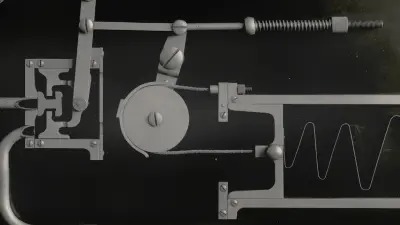For a fast stop: Bosch Servo Brake

“The dashing tempo of the modern automobile offers a particular thrill which nobody can resist and which no motorist willingly allows himself to be deprived of.”
These are the words with which Bosch’s head of advertising Fritz Seitz begins his essay on an interesting new development at Bosch in January 1927, the servo brake for trucks, followed by the servo brake for passenger cars in 1928.
"Easy on your leg muscles"
Using brake cylinders, the vacuum thus produced could be transferred to the brake drums when the foot brake was depressed, reducing the amount of pressure the driver had to apply to the pedal yet maintaining the same braking performance.
Since the early 1920s, passenger cars had been fitted with brakes on all four wheels, which certainly reduced braking distances: while a car with brakes on two wheels travelling at 35 kilometres an hour had previously only come to a stand after 18 metres, four-wheel brakes reduced this distance to 11 metres.

Braking power
But it must be remembered that this braking power could only be achieved by extreme physical effort. It was not until servo brakes were introduced that the theoretically good braking power of the four-wheel brake could be exploited by a moderate application of force. Servo braking thus utilized the full potential of the four-wheel brake while banishing from the act of braking the element of physical hard work which could sometimes be dangerously deficient in critical situations. In the case of passenger cars, the effect corresponded to an increase in pedal pressure of some 30 kilograms – more than one third of the average human body weight available for braking.
In addition to extra comfort and safety, the servo brake offered economic advantages which Bosch emphasised even in the early product descriptions: a 1928 brochure already stressed that the rapid transportation of goods in connection with tough competition called for high speeds which, however, could only be justified if efficient braking was ensured. The fact that the servo brake caused no additional operating costs – additional fuel consumption, for instance – made it an even more interesting option for the transport industry.

Today, Bosch is a market leader in systems for 4- and 2-wheelers, that make braking efficient and safe – like the ABS or MSC.
From invention to innovation
The design of Dewandre’s System was well thought out, but only became marketable thanks to Bosch. It is thus representative of a method whereby Bosch repeatedly introduced innovations to the automobile industry which, though familiar in their theoretical effectiveness and thus attractive for use in motor vehicles, could only be realized in practice if manufactured in large numbers: the mere idea or its formulation in the shape of a patent was all too often far removed from its realization. This is where Bosch picked up the basic bright idea – in this case the servo brake – and developed it into a marketable product ready for mass production.

Author: Dietrich Kuhlgatz
